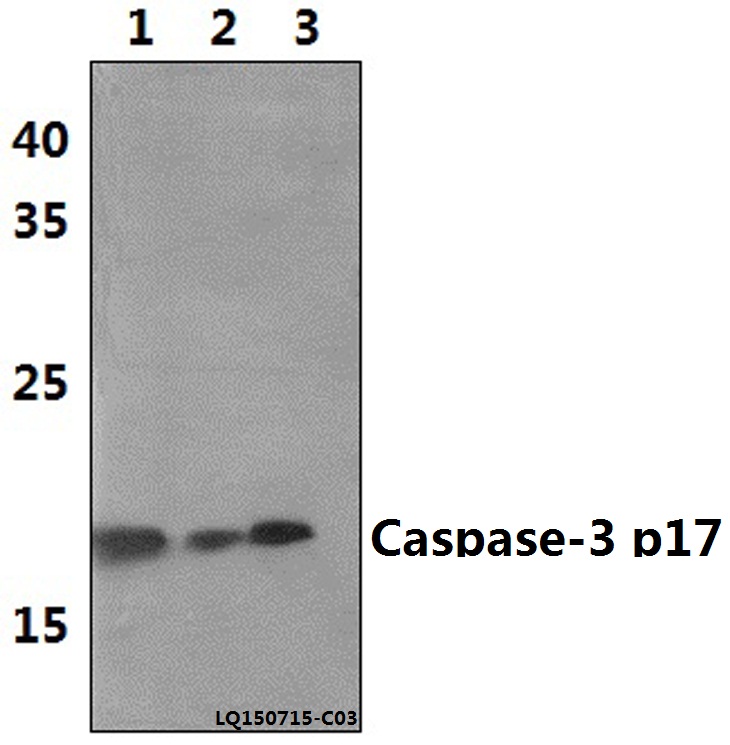Product Name :
Caspase-3 p17 (D175) polyclonal antibody Background :
Caspase 3 (also known as CPP32, YAMA and apopain) is the most extensively studied apoptotic protein among caspase family members. Caspase 3 is synthesized as inactive pro enzyme that is processed in cells undergoing apoptosis by self proteolysis and/or cleavage by other upstream proteases (e.g. Caspases 8, 9 and 10).The processed form of Caspase 3 consists of large (17kD) and small (12kD) subunits which associate to form an active enzyme. Caspase 3 is cleaved at Asp28 - Ser29 and Asp175 - Ser176. The active Caspase 3 proteolytically cleaves and activates other caspases (e.g. Caspases 6, 7 and 9), as well as relevant targets in the cells (e.g. PARP and DFF). Product :
Rabbit IgG, 1mg/ml in PBS with 0.02% sodium azide, 50% glycerol, pH7.2 Storage&Stability :
Store at 4°C short term. Aliquot and store at -20°C long term. Avoid freeze-thaw cycles. Specificity :
Caspase-3 p17 (D175) polyclonal antibody detects endogenous levels of the large fragment (17 kDa) of activated caspase-3 resulting from cleavage adjacent to Asp175. This antibody does not recognize full length caspase-3 or other cleaved caspases. Immunogen :
Synthetic peptide conjugated to KLH derived from within residues 150 - 200 of Human active Caspase 3. Conjugate :
Unconjugated Modification :
Unmodification
Caspase-3 p17 (D175) polyclonal antibody Background :
Caspase 3 (also known as CPP32, YAMA and apopain) is the most extensively studied apoptotic protein among caspase family members. Caspase 3 is synthesized as inactive pro enzyme that is processed in cells undergoing apoptosis by self proteolysis and/or cleavage by other upstream proteases (e.g. Caspases 8, 9 and 10).The processed form of Caspase 3 consists of large (17kD) and small (12kD) subunits which associate to form an active enzyme. Caspase 3 is cleaved at Asp28 - Ser29 and Asp175 - Ser176. The active Caspase 3 proteolytically cleaves and activates other caspases (e.g. Caspases 6, 7 and 9), as well as relevant targets in the cells (e.g. PARP and DFF). Product :
Rabbit IgG, 1mg/ml in PBS with 0.02% sodium azide, 50% glycerol, pH7.2 Storage&Stability :
Store at 4°C short term. Aliquot and store at -20°C long term. Avoid freeze-thaw cycles. Specificity :
Caspase-3 p17 (D175) polyclonal antibody detects endogenous levels of the large fragment (17 kDa) of activated caspase-3 resulting from cleavage adjacent to Asp175. This antibody does not recognize full length caspase-3 or other cleaved caspases. Immunogen :
Synthetic peptide conjugated to KLH derived from within residues 150 - 200 of Human active Caspase 3. Conjugate :
Unconjugated Modification :
Unmodification
-
 Western blot (WB) analysis of Caspase-3 p17 (D175) polyclonal antibody at 1:500 dilution Lane1:Hela cell lysate treated with Lps Lane2:Raw264.7 cell lysate treated with Lps Lane3:PC12 cell lysate treated with Lps
Western blot (WB) analysis of Caspase-3 p17 (D175) polyclonal antibody at 1:500 dilution Lane1:Hela cell lysate treated with Lps Lane2:Raw264.7 cell lysate treated with Lps Lane3:PC12 cell lysate treated with Lps -
 Western blot (WB) analysis of Caspase-3 p17 (D175) pAb at 1:500 dilution Lane1:HepG2 whole cell lysate(40ug) Lane2:HepG2 treated with Etoposide (20ng/ml, 20h) whole cell lysate (40ug) Lane3:HepG2 treated with Etoposide (20ng/ml, 20h,λ-ppase) whole cell lysate (40ug)
Western blot (WB) analysis of Caspase-3 p17 (D175) pAb at 1:500 dilution Lane1:HepG2 whole cell lysate(40ug) Lane2:HepG2 treated with Etoposide (20ng/ml, 20h) whole cell lysate (40ug) Lane3:HepG2 treated with Etoposide (20ng/ml, 20h,λ-ppase) whole cell lysate (40ug)
(S)-ZJM-289 Preconditioning Induces a Late Phase Protection Against Nervous Injury Induced by Transient Cerebral Ischemia and Oxygen-Glucose Deprivation
PMCID: Pubmed No.:24277159
Hydrogen sulfide attenuates hypoxia-induced neurotoxicity through inhibiting microglial activation
PMCID: Pubmed No.:24788079
Paraspeckle Protein 1 (PSPC1) Is Involved in the Cisplatin Induced DNA Damage Response—Role in G1/S Checkpoint
PMCID: Pubmed No.:24819514
Anacardic acid induces cell apoptosis associated with induction of ATF4-dependent endoplasmic reticulum stress
PMCID: Pubmed No.:24853302
NG as a novel nitric oxide donor induces apoptosis by increasing reactive oxygen species and inhibiting mitochondrial function in MGC803 cells
PMCID: Pubmed No.:25135879
Heat shock protein gp96 decreases p53 stability by regulating Mdm2 E3 ligase activity in liver cancer
PMCID: Pubmed No.:25637791
Reg3g Promotes Pancreatic Carcinogenesis in a Murine Model of Chronic Pancreatitis
PMCID: Pubmed No.:26182900
NG as a novel nitric oxide donor induces apoptosis by increasing reactive oxygen species and inhibiting mitochondrial function in MGC803 cells
PMCID: Pubmed No.:25135879
(S)-ZJM-289 Preconditioning Induces a Late Phase Protection Against Nervous Injury Induced by Transient Cerebral Ischemia and Oxygen-Glucose Deprivation
PMCID: Pubmed No.:24277159
Hydrogen sulfide attenuates hypoxia-induced neurotoxicity through inhibiting microglial activation
PMCID: Pubmed No.:24788079
Paraspeckle Protein 1 (PSPC1) Is Involved in the Cisplatin Induced DNA Damage Response—Role in G1/S Checkpoint
PMCID: Pubmed No.:24819514
IL-33 Provides Neuroprotection through Suppressing Apoptotic, Autophagic and NF-κB-Mediated Inflammatory Pathways in a Rat Model of Recurrent Neonatal Seizure
PMCID: Pubmed No.:29311813
Clostridium butyricum pretreatment attenuates cerebral ischemia/reperfusion injury in mice via anti-oxidation and anti-apoptosis
PMCID: Pubmed No.:26733300
Cadmium pyrithione suppresses tumor growth in vitro and in vivo through inhibition of proteasomal deubiquitinase
PMCID: Pubmed No.:29098502
The Glutaminase-1 Inhibitor 968 Enhances Dihydroartemisinin-Mediated Antitumor Efficacy in Hepatocellular Carcinoma Cells
PMCID: Pubmed No.:27835669
C1 inhibitor‑mediated myocardial protection from chronic intermittent hypoxia‑induced injury
PMCID: Pubmed No.:27698713
Jinmaitong decreases sciatic nerve DNA oxidative damage and apoptosis in a streptozotocin-induced diabetic rat model
PMCID: Pubmed No.:26622393
Two clinical drugs deubiquitinase inhibitor auranofin and aldehyde dehydrogenase inhibitor disulfiram trigger synergistic anti-tumor effects in vitro and in vivo
PMCID: Pubmed No.:26625200
The circadian clock gene Bmal1 facilitates cisplatin-induced renal injury and hepatization
PMCID: Pubmed No.:32522976
Exogenous Hydrogen Sulfide Offers Neuroprotection on Intracerebral Hemorrhage Injury Through Modulating Endogenous H2S Metabolism in Mice
PMCID: Pubmed No.:31440142
The loss of dopaminergic neurons in DEC1 deficient mice potentially involves the decrease of PI3K/Akt/GSK3β signaling
PMCID: Pubmed No.:31884423
IL-33 Alleviated Brain Damage via Anti-apoptosis, Endoplasmic Reticulum Stress, and Inflammation After Epilepsy.
PMCID: Pubmed No.:32982679
Tachykinin NK1 receptor antagonist L-733,060 and substance P deletion exert neuroprotection through inhibiting oxidative stress and cell death after traumatic brain injury in mice
PMCID: Pubmed No.:30593954
(−)-Epigallocatechin Gallate (EGCG) Enhances the Sensitivity of Colorectal Cancer Cells to 5-FU by Inhibiting GRP78/NF-κB/miR-155-5p/MDR1 Pathway
PMCID: Pubmed No.:30741544
Epidermal growth factor‐containing fibulin‐like extracellular matrix protein 1 (EFEMP1) suppressed the growth of hepatocellular carcinoma cells by promoting Semaphorin 3B(SEMA3B)
PMCID: Pubmed No.:30972979
Overexpression of HACE1 in gastric cancer inhibits tumor aggressiveness by impeding cell proliferation and migration
PMCID: Pubmed No.:29673126
LncRNA SNHG6 Inhibits Apoptosis by Regulating EZH2 Expression via the Sponging of MiR-101-3p in Esophageal Squamous-Cell Carcinoma
PMCID: Pubmed No.:33192074
Diterpene pekinenal from euphorbia pekinensis radix induced IEC-6 cells apoptosis mediated by mitochondria and death receptors
PMCID: Pubmed No.:30710624
Prodigiosin isolated from Serratia marcescens in the Periplaneta americana gut and its apoptosis‑inducing activity in HeLa cells
PMCID: Pubmed No.:30942457
Konjac glucomannan reverses multi‑drug resistance of HepG2/5‑FU cells by suppressing AKT signaling and increasing p53 expression
PMCID: Pubmed No.:32782527
Brain Microvascular Endothelial Cell-Derived Exosomes Protect Neurons from Ischemia–Reperfusion Injury in Mice
PMCID: Pubmed No.:36297399
Bioworld Biotech only provide peptides for our antibodies and do not provide additional peptide customization services.
Price/Size :
USD 368/1mg/vial
Tips:
For phospho antibody, we provide phospho peptide(0.5mg) and non-phospho peptide(0.5mg).Describe :
Blocking peptides are peptides that bind specifically to the target antibody and block antibody binding. These peptide usually contains the epitope recognized by the antibody. Antibodies bound to the blocking peptide no longer bind to the epitope on the target protein. This mechanism is useful when non-specific binding is an issue, for example, in Western blotting (WB) and Immunohistochemistry (IHC). By comparing the staining from the blocked antibody versus the antibody alone, one can see which staining is specific; Specific binding will be absent from the western blot or IHC performed with the neutralized antibody.Formula:
Synthetic peptide was lyophilized with 100% acetonitrile and is supplied as a powder. Reconstitute with 0.1 ml DI water for a final concentration of 10 mg/ml.The purity is >90%,tested by HPLC and MS.
Storage:
The freeze-dried powder is more stable. For short time at 2-8°C. For long term storage store at -20°C.
Note :
This product is for research use only (RUO only). Not for use in diagnostic or therapeutic procedures.
 Caspase-3 p17 (D175) polyclonal antibody
Caspase-3 p17 (D175) polyclonal antibody  Datasheet
Datasheet COA
COA MSDS
MSDS SHIP
SHIP